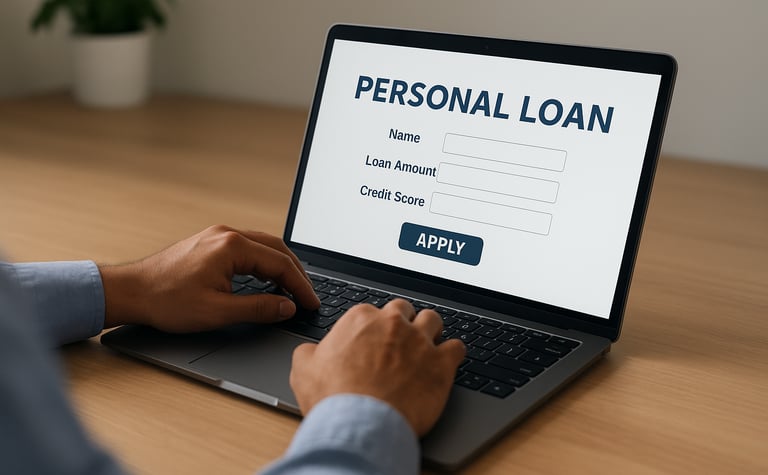A Complete Guide to Personal Loans in the USA (2025 Update)
Introduction
When it comes to managing unexpected expenses or consolidating debt, personal loans have become one of the most popular financial solutions in the United States. Millions of Americans rely on them each year for everything from medical bills to home improvements.
But before applying for a personal loan, it’s important to understand how it works, who qualifies, and the pros and cons that come with borrowing. This comprehensive guide will walk you through everything you need to know about personal loans in the USA in 2025 — so you can make informed and responsible financial decisions.
What Is a Personal Loan?
A personal loan is a type of installment loan that allows you to borrow a fixed amount of money from a lender and repay it in regular monthly payments (usually with interest) over a set period of time.


Secured vs. Unsecured Personal Loans
Secured Loans: Backed by collateral, such as a car or savings account. Since there is security involved, the interest rates may be lower.
Unsecured Loans: Do not require collateral. Approval depends mostly on your credit score, income, and repayment history. These are more common in the US.
Why People Take Personal Loans in the USA
Personal loans can be used for almost any purpose. Some of the most common reasons include:
Debt Consolidation: Combining multiple debts into one manageable monthly payment.
Emergency Expenses: Covering sudden medical bills, car repairs, or urgent needs.
Home Renovations: Financing upgrades or repairs without dipping into savings.
Wedding or Vacation: Funding big life events or travel.
Major Purchases: Electronics, furniture, or appliances.
Eligibility Criteria for Personal Loans in the USA
While each lender has its own requirements, most borrowers must meet the following conditions:
1. Credit Score
A higher credit score (typically 670 or above) increases the chances of approval and lowers interest rates. Some lenders offer loans to borrowers with fair or poor credit, but at higher costs.
2. Income and Employment
Lenders want to ensure you have a stable income source. Proof of employment or steady income is usually required.
3. Age and Residency
You must be at least 18 years old and a legal resident or citizen of the United States.
4. Debt-to-Income Ratio
A lower debt-to-income (DTI) ratio improves approval chances. Most lenders prefer a DTI under 36%.
How to Apply for a Personal Loan in the USA
Applying for a personal loan is easier than ever in 2025. Here are the main options:
1. Online Lenders
Digital lenders are popular for their quick approval and fast funding. Many allow you to apply online, check eligibility without affecting your credit score, and receive money within a day or two.
2. Banks and Credit Unions
Traditional banks and credit unions often provide personal loans with competitive rates, especially if you already have an account with them. However, approval can take longer.
3. Steps to Apply
Check your credit score.
Compare lenders and rates.
Gather required documents (ID, proof of income, bank statements).
Submit an application.
Review terms and sign the agreement.
Receive funds directly in your bank account.
Pros and Cons of Personal Loans
Like any financial product, personal loans come with benefits and drawbacks.
✅ Pros
Quick Approval: Some lenders fund loans within 24 hours.
No Collateral Required: Many loans are unsecured.
Fixed Payments: Predictable monthly installments.
Flexible Use: Can be used for almost any purpose.
❌ Cons
Higher Interest Rates (especially with poor credit).
Potential Fees: Origination fees, late payment fees, and prepayment penalties.
Risk of Debt Trap: Borrowing without planning can lead to more debt.
Tips to Improve Your Chances of Approval
If you want better rates and higher chances of approval, consider these strategies:
Maintain a Good Credit Score: Pay bills on time, keep balances low, and avoid unnecessary credit applications.
Reduce Existing Debt: Lowering your debt-to-income ratio makes you more attractive to lenders.
Compare Lenders: Don’t just apply to the first lender you see. Shop around for the best interest rates and terms.
Borrow Only What You Need: Keep loan amounts realistic to avoid unnecessary debt.
Alternatives to Personal Loans
Sometimes a personal loan isn’t the best option. Here are alternatives to consider:
Credit Cards: For smaller purchases or short-term needs.
Home Equity Line of Credit (HELOC): For homeowners with equity in their property.
Peer-to-Peer Lending: Borrowing directly from individuals via online platforms.
401(k) Loan: If you have a retirement account, some plans allow borrowing against it.
Things to Watch Out For
While personal loans are helpful, it’s important to avoid pitfalls:
Be careful of predatory lenders offering extremely high interest rates.
Always read the terms and conditions before signing.
Don’t borrow more than you can realistically repay.
Conclusion
A personal loan in the USA can be a smart financial tool if used responsibly. Whether you’re consolidating debt, handling an emergency, or planning a major life event, it offers flexibility and convenience.
Before applying, always compare multiple lenders, check your credit score, and calculate how much you can afford to repay. Borrowing responsibly ensures that a personal loan helps you achieve your financial goals instead of creating new problems.
Remember: Personal loans are not “free money.” They are commitments that require careful planning. Take the time to research your options, and make the choice that’s right for your financial future.

